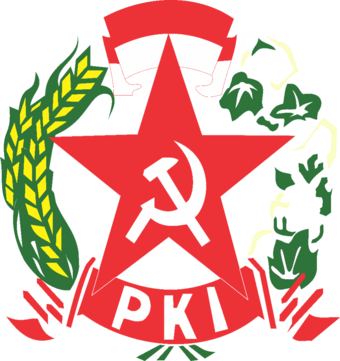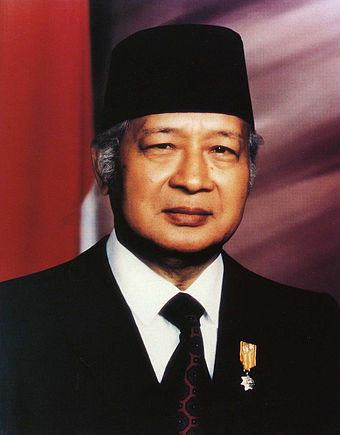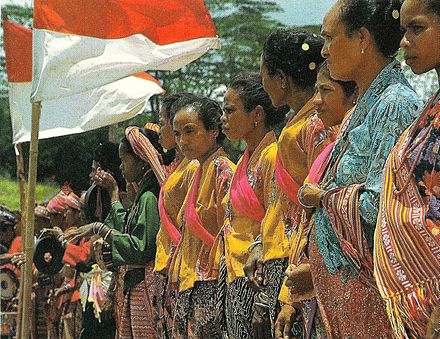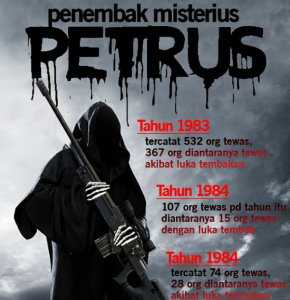The New Order
Transition to the New Order
Described as the great dalang (“puppet master”), Sukarno’s position depended on balancing the opposing and increasingly hostile forces of the army and the PKI. Sukarno’s anti-imperialist ideology saw Indonesia increasingly dependent on Soviet and then communist China. By 1965, the PKI was the largest communist party in the world outside the Soviet Union or China. Penetrating all levels of government, the party increasingly gained influence at the expense of the army.
On 30 September 1965, six of the most senior generals within the military and other officers were assassinated in an attempted coup. The insurgents, known later as the 30 September Movement, backed a rival faction of the army and took up positions in the capital, later seizing control of the national radio station. They claimed they were acting against a plot organised by the generals to overthrow Sukarno. Within a few hours, Major General Suharto, commander of the Army Strategic Reserve (Kostrad), mobilised counteraction, and by the evening of 1 October, it was clear that the coup, which had little co-ordination and was largely limited to Jakarta, had failed. Complicated and partisan theories continue to this day over the identity of the attempted coup’s organisers and their aims. According to the Indonesian army, the PKI were behind the coup and used disgruntled army officers to carry it out, and this became the official account of Suharto’s subsequent New Order administration. Most historians agree that the coup and the surrounding events were not led by a single mastermind controlling all events, and that the full truth will never likely be known.
The PKI was blamed for the coup, and anti-communists, initially following the army’s lead, went on a violent anti-communist purge across much of the country. The PKI was effectively destroyed, and the most widely accepted estimates are that between 500,000 and 1 million were killed. The violence was especially brutal in Java and Bali. The PKI was outlawed and possibly more than 1 million of its leaders and affiliates were imprisoned.
Throughout the 1965–66 period, President Sukarno attempted to restore his political position and shift the country back to its pre-October 1965 position but his Guided Democracy balancing act was destroyed with the PKI’s demise. Although he remained president, the weakened Sukarno was forced to transfer key political and military powers to General Suharto, who by that time had become head of the armed forces. In March 1967, the Provisional People’s Consultative Assembly (MPRS) named General Suharto acting president. Suharto was formally appointed president in March 1968. Sukarno lived under virtual house arrest until his death in 1970.

Entrenchement of the New Order
In the aftermath of Suharto’s rise, hundreds of thousands of people were killed or imprisoned by the military and religious groups in a backlash against alleged communist supporters, with direct support from the United States. Suharto’s administration is commonly called the New Order era. Suharto invited major foreign investment, which produced substantial, if uneven, economic growth. However, Suharto enriched himself and his family through business dealings and widespread corruption.

Annexation of West Irian
At the time of independence, the Dutch retained control over the western half of New Guinea (also known as West Irian), and permitted steps towards self-government and a declaration of independence on 1 December 1961. After negotiations with the Dutch on the incorporation of the territory into Indonesia failed, an Indonesian paratroop invasion 18 December preceded armed clashes between Indonesian and Dutch troops in 1961 and 1962. In 1962 the United States pressured the Netherlands into secret talks with Indonesia which in August 1962 produced the New York Agreement, and Indonesia assumed administrative responsibility for West Irian on 1 May 1963.
Rejecting UN supervision, the Indonesian government under Suharto decided to settle the question of West Irian, the former Dutch New Guinea, in their favour. Rather than a referendum of all residents of West Irian as had been agreed under Sukarno, an ‘Act of Free Choice’ was conducted in 1969 in which 1,025 Papuan representatives of local councils were selected by the Indonesians. They were warned to vote in favour of Indonesian integration with the group unanimously voting for integration with Indonesia. A subsequent UN General Assembly resolution confirmed the transfer of sovereignty to Indonesia.
West Irian was renamed Irian Jaya (‘glorious Irian’) in 1973. Opposition to Indonesian administration of Irian Jaya (later known as Papua) gave rise to guerrilla activity in the years following Jakarta’s assumption of control.
Annexation of East Timor
In 1975, the Carnation Revolution in Portugal caused authorities there to announce plans for decolonisation of Portuguese Timor, the eastern half of the island of Timor whose western half was a part of the Indonesian province of East Nusa Tenggara. In the East Timorese elections held in 1975, Fretilin, a left-leaning party, and UDT, aligned with the local elite, emerged as the largest parties, having previously formed an alliance to campaign for independence from Portugal. Apodeti, a party advocating integration with Indonesia, enjoyed little popular support.
Indonesia alleged that Fretilin was communist, and feared that an independent East Timor would influence separatism in the archipelago. Indonesian military intelligence influenced the break-up of the alliance between Fretilin and UDT, which led to a coup by the UDT on 11 August 1975 and the start of a month-long civil war. During this time, the Portuguese government effectively abandoned the territory and did not resume the decolonisation process. On 28 November, Fretilin unilaterally declared independence, and proclaimed the ‘Democratic Republic of East Timor’. Nine days later, on 7 December, Indonesia invaded East Timor, eventually annexing the tiny country of (then) 680,000 people. Indonesia was supported materially and diplomatically by the United States, Australia, and the United Kingdom, who regarded Indonesia as an anti-communist ally.
Following the 1998 resignation of Suharto, the people of East Timor voted overwhelmingly for independence in a UN-sponsored referendum held on 30 August 1999. About 99% of the eligible population participated; more than three quarters chose independence despite months of attacks by the Indonesian military and its militia. After the result was announced, elements of the Indonesian military and its militia retaliated by killing approximately 2,000 East Timorese, displacing two-thirds of the population, raping hundreds of women and girls, and destroying much of the country’s infrastructure. In October 1999, the Indonesian parliament (MPR) revoked the decree that annexed East Timor, and the United Nations Transitional Administration in East Timor (UNTAET) assumed responsibility for governing East Timor until it officially became an independent state in May 2002.

Transmigration
The Transmigration program (Transmigrasi) was a National Government initiative to move landless people from densely populated areas of Indonesia (such as Java and Bali) to less populous areas of the country including Papua, Kalimantan, Sumatra, and Sulawesi. The stated purpose of this program was to reduce the considerable poverty and overpopulation on Java, to provide opportunities for hard-working poor people, and to provide a workforce to better utilise the resources of the outer islands. The program, however, has been controversial, with critics accusing the Indonesian Government of trying to use these migrants to reduce the proportion of native populations in destination areas to weaken separatist movements. The program has often been cited as a major and ongoing factor in controversies and even conflict and violence between settlers and indigenous populations.

Petrus Killings
Penembak Misterius – The Petrus Killings The Petrus killings were a series of extrajudicial executions in Indonesia that occurred between 1983 and 1985 under President
